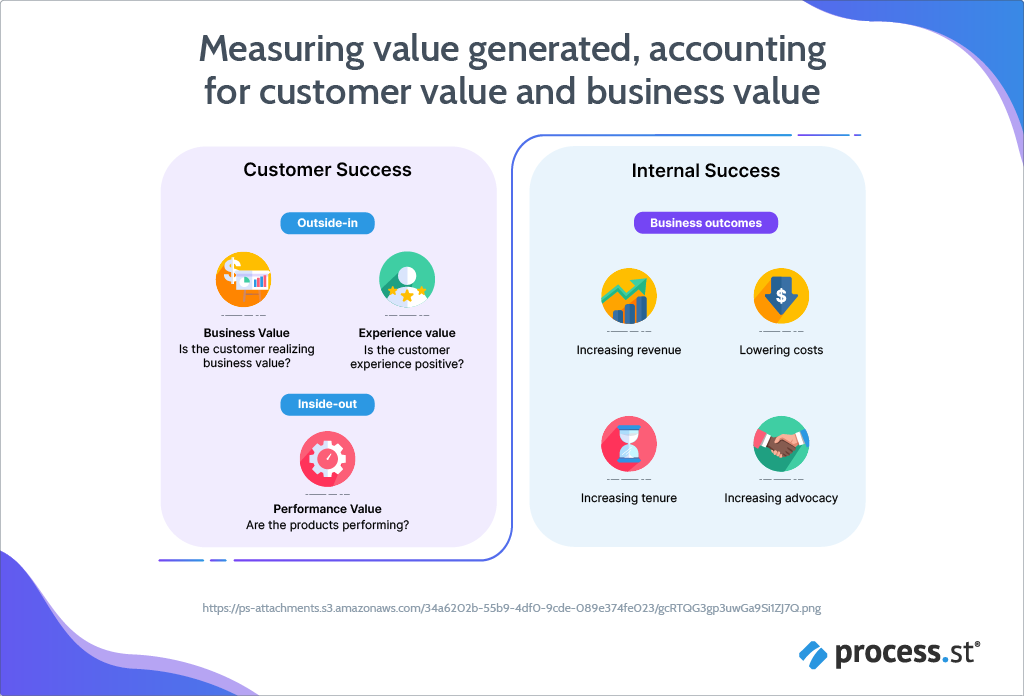
According to Deloitte Insights, advances in technology are changing the business landscape and they are calling this a digital disruption. This is altering customer expectations and demands, presenting critical challenges for customer success teams globally.
To successfully ride this wave of change, Deloitte – and us here at Process Street – believe businesses should rethink how they are measuring value delivered to the customer. The aim is to ensure these measurements are customer-centric to refine CS activities and enhance the customer’s experience.
Think of it as a customer success evolution in response to digital disruption.
This CS transformation has the potential to bolster positive referrals by 83%, lower costs by 20%, and increase customer lifetime value by x1.6.
What have you got to lose?
In this article, you’ll learn how to apply a customer-centric means of measuring customer value generated for your organization. I’ve split the process down into three steps based on the Customer-Centric Digital Transformation report by Deloitte.
- From churn reduction to customer value generation (applying customer success 2.0)
- Measuring value in 3 steps: Determining customer and internal success
- Determining value generated – Step #1: Measure the outside-in value perception
- Determining value generated – Step #2: Measuring inside-out value perception
- Determining value generated – Step #3: Measuring internal success using business outcomes
With that said, let’s jump straight to it!
From churn reduction to customer value generation (applying customer success 2.0)
Cloud computing, anything-as-a-service (XaaS), and the Internet of Things (IoT) have solidified the need for businesses to update their customer success strategy. Rather than focusing on selling, organizations need to nourish healthy customer relationships. This is a key aspect of what we call customer success 2.0.
“Several recent trends indicate that we’re at the beginning of a new era – call it customer success 2.0 – in which many companies are focusing on growth in addition to churn.” – McKinsey & Company, Introducing customer success 2.0: The new growth engine
If you read my last article, Customer Success 2.0: The Essential Software Stack to Execute McKinsey’s Model, you’d know that businesses are moving into a new era of customer success. One that prioritizes reactive customer success processes rather than reactive ones.
- Customer success 1.0: Focuses on churn reduction and risk management.
- Customer success 2.0: Recognizes customer success as a growth engine. Focuses on building solid customer-business relationships, helping the customer grow with the organization and realize their goals. Business monetization models are developed with customer retention and value creation in mind.
With this shift in focus, organizations are lowering their costs to serve, improving customer’s willingness to spend, increasing loyalty, and bettering brand advocacy.
Other benefits include:
- Improved customer spend : Research shows that 62% of B2B customers purchase more from companies after a good customer experience.
- Increased tenure : Relationship building improves customer spend alongside trust, with loyal customers spending 67% more than new ones. Adding to this, Forrester Consulting concluded that experience-driven businesses grew revenue x1.4 faster and increased customer lifetime value x1.6 more relative to companies employing outdated customer 1.0 strategies.
- Reduced cost of service ️: Optimizing the customer journey to maximize satisfaction can increase the cost of serving B2B customers by ~20%.
- More referrals ️: After a positive experience, 83% of customers would be happy to provide a referral if asked.
Applying the customer success 2.0 approach means evolving the CS function beyond selling and churn reduction, to use business monetization models that focus on customer retention and value creation. This article focuses on the value creation aspect of customer success 2.0 and explains how you should measure this.
Measuring value in 3 steps: Determining customer and internal success
“To measure is to know. If you cannot measure it, you cannot improve it.” – Lord Kelvin
Creating and delivering value under the customer success 2.0 framework starts by articulating the customer’s outside-in view of value, a company’s inside-out product view of value, and business outcomes (as shown in the image below).

The above image illustrates your new method for measuring customer value. As you can see, both company and customer benefits are encapsulated in this measure. Your aim, when applying this approach, is to bridge the gap between customer success and internal business success.
The steps detailed below explain how you can apply this new way of measuring value generated.
Determining value generated – Step #1: Measure the outside-in value perception
An outside-in perspective is about listening and providing value to your customers. You want your customers to choose you over your competition, and for that you need to meet their exact needs. Measuring the outside-in value perception means determining business value and experience value, as shall be explained.
Business value: Is the customer realizing business value?
Business value results from the intersection of three dimensions:
- What you can implement successfully and sustainably.
- What your customers want and will buy (even if they don’t know it yet).
- What your team is excited about creating.
How do you measure business value? Thinking about this question, I looked at how top organizations were doing this. This is where I came across Scrum Inc. – a software company providing global authority on the widely used agile framework, Scrum.
Scrum Inc. describes 4 pillars that measure business value:
- Pillar #1: Business activities are categorized and tiered into parallel workflows. Catagories used include growth and innovation, value and revenue creation, and Keeping the Lights On (KLO) activities. In effect, each tiered category describes the value given for that business activity.

- Pillar #2: Every business has a vision of value. For Scrum Inc., that vision is updated regularly using multiple parallel planning, review, and retrospective cadences.
- Pillar #3: The Net Present Value (NPV) is calculated for each business epic (an epic is a chunk of work dedicated to one common objective). The formula detailed below is used to calculate the NPV.

- Pillar #4: Epics are prioritized according to their NPV score. This way, business activities with the highest business value are delivered first.
Scrum Inc. relies on NPV scoring to dictate the business value of activities. Let’s think back to the three dimensions of business value to understand how the NPV score does this:
- The nature of a low NPV score dictates a business activity as unsustainable.
- Business activities that meet the customer’s needs are likely to be associated with a positive cash flow, and therefore, will deliver a high NPV score.
- Business activities that your team is excited about will have more time dedicated to them and hence deliver higher NPV scores.
Experience value: Is the customer’s experience positive?
Most companies understand the basic premise that measuring customer experience is vital for understanding whether a customer is enjoying that experience. What is less well known is how to measure customer experience effectively. Most businesses turn to customer experience KPI measures, but how do you know what measure to use? What makes a good KPI measure?
For instance, I went through a phase of purchasing hiking rucksacks from one particular outdoor equipment brand. In the beginning, I loved this brand – the rucksacks fitted well, were excellent value for money, and had many pockets (my biggest bugbear is a bag without enough pockets). Yet, after a few months of use, the chest straps ripped off from every single bag I owned. This meant that, although I initially liked the product, I wouldn’t repeat my purchase or recommend the products to a friend. In this instance, my customer experience wasn’t positive, and a good KPI would pick this up.
It’s important for your CS team to feel they are able to influence your KPI metrics. Without this influence, your KPIs become a number and a potentially demotivated one.
Under this view, the 4 key KPI measures you must use to measure customer experience are detailed in the table below.

It’s important to note that although it’s recommended you use the above KPI measures, also think about the KPIs uniquely important for your business, as exemplified in the video below.
Determining value generated – Step #2: Measuring inside-out value perception
An inside-out value perception looks at a company’s capabilities and strengths, taking into account an organization’s resources and how these can be used more efficiently. Measuring inside-out value is achieved by measuring performance value.
Performance value: Are the products performing?
Your aim is to provide high-value products/services with low costs and diminished time-to-market.
To measure value performance, don’t solely focus on your main offering. Take a holistic approach that accounts for the cohesive delivery of your products and services. That is, measure performance using a product-service system (PSS).
A PSS system looks at a business offering in terms of both its products, the services provided, supporting networks, and infrastructure.
Performance value is measured using KPIs. To meet the demands of a PSS, the KPIs chosen need to follow SMART principles. That is, KPIs should be specific, be measurable, be attainable, be realistic and be timely.
Following the principle of what cannot be measured cannot be improved and the plan-do-act-check methodology, you need to continuously monitor your PSS using your selected KPIs.
Examples of SMART KPIs you can use to monitor your PSS are listed below:
- Satisfaction
- Acceptance rate
- Number of identified customer needs
- On-time delivery
- Rescheduling quota
- Product flexibility
- Technical ability
- Service reliability
- Service assurance
- Development cost
- Number of bottlenecks
- Scheduling inefficiency
- Defects detected in the development stage
To implement these KPIs along with the plan-do-act-check methodology, use Process Street‘s PDCA Cycle Change Management Model Process Checklist.
Process Street is a no-code solution helping you document and automate your business workflows. In this instance, we’re talking about workflow documentation to help you employ continuous improvement as a philosophy for your organization, to maintain excellent business performance.
Create your free Process Street account to get started!
Click here to access our PDCA Cycle Change Management Model Process Checklist!
Key workflow features:
- Approvals: Enabling team members to give the go-ahead or rejection on important items. Approval for each stage in the PDCA cycle is required. This feature supports teamwork, meaning the user cannot progress in the workflow until the required approval has been obtained.
- Stop Tasks: Maintain task order. This acts as a form of control, standardizing the PDCA process, making sure tasks are completed in the correct order.
- Role Assignments: Meaning the relevant team members can be assigned to tasks as required. This coordinates inter/intra-team collaboration to effectively execute the PDCA cycle.
Determining value generated – Step #3: Measuring internal success using business outcomes
Measuring internal success is more self-explanatory. You’ll want to look for increasing revenue, tenure, advocacy, and lowered costs.
- Measure business revenue : Undertake profitability analysis by calculating your margin/profitability ratio, your gross profit margin ratio, net profit margin ratio, and conduct a break-even analysis.
- Measure business advocacy : When customers are deeply connected and involved with a company, advocacy comes naturally. Customer advocacy is measured by gauging the monetary effect on the company from voluntary customer behavior.
- Measure business tenure : Calculate your average customer tenure and gain a measure for the life expectancy of new customers when they subscribe to your service. To determine the lifetime value of a customer (LTV) find out: How much you earn from them on average for each month (ARPU); the average costs associated with every new customer (CAC); costs associated with servicing a new customer (CTS), and how long you can expect them to remain a customer (tenure).
- Measure business cost : Costs are mandatory expenses made for the smooth running of a business. Every business activity will have a cost associated. Measure direct, indirect, fixed, variable, operating, product and period costs associated with your organization.
Putting it all together: Measuring customer value in customer success
Business value, experience value, and performance value measures give an accurate representation of customer success. Combine this with business outcome measures – aka, revenue, tenure, costs, and advocacy – to get a comprehensive and holistic view determining value generated by a given organization.
This new approach to measuring value generated is customer-centric, helping you apply the customer 2.0 framework to your organization. This will allow your customers to realize their goals and grow with you.
As customers increasingly seek always-on, performance-based, and integrated solutions, measuring value generated using this new approach gives you the data and information needed to maximize customer value to enhance their experience with you.
For more information on how you can adapt and refine your customer success operations, check out more of Process Street‘s articles, for free, by visiting our blog. We also have a wealth of free workflow resources, specifically designed for CS teams to implement best practices. Check out our workflow library here.
“[Process Street] allows the team to keep track of our customers, to see the exact phase of the journey they’re in, including the specific tasks being completed. The integration with our CRM is awesome and very helpful. – GetApp, Percy H.
How does your CS team measure customer value generated? What challenges and successes have they faced? We’d love to hear from you, please comment below!







 Workflows
Workflows Projects
Projects Data Sets
Data Sets Forms
Forms Pages
Pages Automations
Automations Analytics
Analytics Apps
Apps Integrations
Integrations
 Property management
Property management
 Human resources
Human resources
 Customer management
Customer management
 Information technology
Information technology



Jane Courtnell
Hi there, I am a Junior Content Writer at Process Street. I graduated in Biology, specializing in Environmental Science at Imperial College London. During my degree, I developed an enthusiasm for writing to communicate environmental issues. I continued my studies at Imperial College's Business School, and with this, my writing progressed looking at sustainability in a business sense. When I am not writing I enjoy being in the mountains, running and rock climbing. Follow me at @JaneCourtnell.